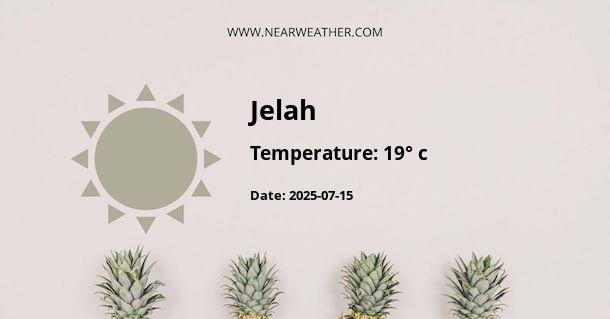Climate and Weather in Jelah, Bosnia and Herzegovina: An In-Depth Overview
The town of Jelah is nestled within the heart of Bosnia and Herzegovina (BA), slightly to the north of the country's geographical center. It experiences a climate that is influenced by both the Mediterranean and continental air masses, resulting in a humid subtropical climate (Cfa) according to the Köppen climate classification, with features of an oceanic climate (Cfb) in some areas due to the higher elevations. This creates a unique weather pattern characterized by warm summers, cool winters, and precipitation fairly evenly distributed throughout the year.
Seasonal Climate Overview
Jelah’s weather varies distinctly with each season, offering a dynamic climatic experience ranging from hot, sunny summers to cold, snowy winters.
Spring
- Temperature: Average highs range from 13°C (55°F) in March to 23°C (73°F) in May. Lows can drop to 2°C (35°F) in March, gradually warming to 9°C (48°F) by May.
- Precipitation: Rainfall is common with the spring months receiving an average of 80-100mm (3.1-3.9 inches) per month.
- Weather Events: Occasional thunderstorms and rapid weather changes as winter transitions to summer.
Summer
- Temperature: Average highs in July can reach up to 26°C (78°F), with lows rarely falling below 12°C (53°F).
- Precipitation: Despite being the warmest period of the year, summer can also experience significant rainfall, averaging 80mm (3.1 inches) per month.
- Weather Events: Thunderstorms are relatively frequent during the summer months.
Fall
- Temperature: Average high temperatures decrease from 22°C (71°F) in September to 12°C (53°F) in November. Lows range from 9°C (48°F) in September to 3°C (37°F) in November.
- Precipitation: Rainfall increases in the autumn, with a month-over-month rise leading to a wet November, which can see up to 110mm (4.3 inches).
- Weather Events: Mist and fog can occur frequently due to the temperature fluctuations between day and night.
Winter
- Temperature: Average highs hover around 4°C (39°F) and lows can fall to -3°C (26°F), although extreme lows can reach -10°C (14°F) during cold waves.
- Precipitation: Snow is common, and January is typically the coldest and snowiest month, with snowfall averaging around 40cm (15.7 inches).
- Weather Events: Snowstorms and icy conditions can lead to disruptions in transportation and other services.
Monthly Weather Details
| Month | High/Low (°C) | Precipitation (mm) |
|---|---|---|
| January | 3/-3 | 70 |
| February | 6/-1 | 65 |
| March | 13/2 | 60 |
| April | 16/6 | 70 |
| May | 23/9 | 80 |
| June | 26/12 | 80 |
| July | 30/13 | 70 |
| August | 29/13 | 70 |
| September | 22/9 | 90 |
| October | 16/6 | 100 |
| November | 10/2 | 110 |
| December | 4/-1 | 80 |
Extreme Weather and Climate Shifts
In recent years, climate change has had an observable impact on weather patterns in Jelah and the surrounding regions of Bosnia and Herzegovina. There is an increasing trend in the number of extreme weather events such as severe storms, flooding, and higher than usual temperatures in summer months.
Research and Observations
Climate experts have noted a gradual increase in average temperatures over the decades, consistent with global warming trends. This has led to an alteration in precipitation patterns and the extension of the summer season, resulting in both longer dry spells and more intense rainy periods.
Factors Influencing Jelah's Climate
The climate in Jelah is affected by multiple geographical and atmospheric factors:
- Proximity to the Adriatic Sea: Modifies the humidity and temperature levels, especially in the summer.
- Elevation: Jelah's elevation plays a role in its precipitation patterns and the coolness of its climate, particularly in the winter months.
- Topography: The surrounding Dinaric Alps shape the movement of air masses and influence localized weather conditions.
- Latitudinal Position: Its northern hemisphere location means Jelah experiences four distinct seasons, with longer days in summer and shorter daylight hours in winter.
Climate Adaptations and Recommendations
Residents and visitors of Jelah should consider the seasonal variability of the climate when planning activities:
- Construction: Buildings, roads, and infrastructure need to be designed to handle the weight of snow in the winter and provide cooling options for the hot summer months.
- Agriculture: Farming practices should account for the changing precipitation patterns to ensure sustainable food production.
- Tourism: The weather allows for year-round tourism, with skiing in the winter months and hiking, cultural festivals, and sightseeing dominating the summer schedule.
- Weather Preparedness: It is crucial for the local population to stay informed about weather forecasts and advisories to anticipate and mitigate the effects of severe weather, particularly in light of the evolving patterns due to climate change.
Your content should encapsulate the nuance of Jelah's weather patterns, backed by meteorological data and expert analysis. Understanding the local climate not only drives the region's economy and lifestyle but also serves as a critical component in future planning and development against the backdrop of a changing global climate.
A - Jelah's Latitude is 44.654171 & Longitude is 17.958059.
A - Weather in Jelah is 8° today.
A - Climate Conditions in Jelah shows few clouds today.
A - Humidity in Jelah is 76% today.
A - Wind speed in Jelah is 11.41 km/h, flowing at 171° wind direction. today.
